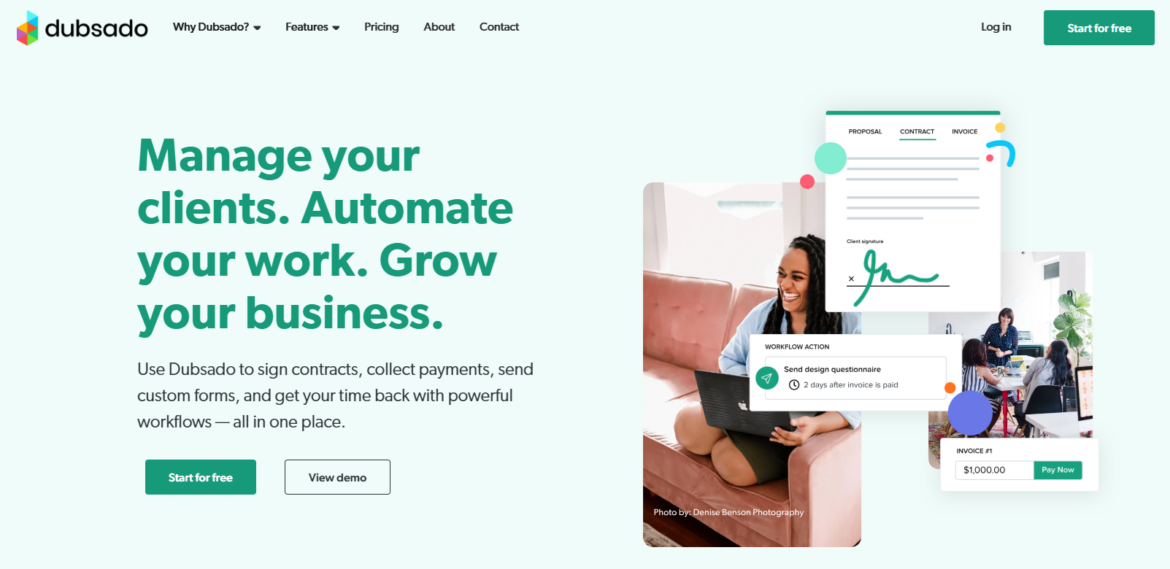Networking can be enormously time consuming.
Let it run amok, and it’s a full time job. Ignore it, and you’ve stranded yourself on your own marketing island, having to generate all of the leads for your business by yourself.
Neither of these extremes will help you thrive as a business owner.
Instead, you need a networking strategy, and the right tools and tips to implement it.
In this guide to networking for interior designers, we show you exactly how to network and grow your business. No fluff. Only expert advice.
Table of Contents
Why networking is essential for interior designers
Interior design is one of the many businesses that rely largely on word of mouth. Unless you have a massive social media presence or rank in search engines for target keyphrases, the likelihood is that the majority of your leads will come from referrals.
Of course, we live in a digital world, and clients will want to see that you do have a social media following and a gorgeous website and portfolio. But the way that paying clients arrive at your digital world is often still via referral.
Designers who are excellent at networking can build a profitable design business in their first year. And those who continue to network guarantee that they will always have more leads than they can handle.

How to approach networking strategically (based on your business goals)
Networking with the WRONG people equates to wasted time and lost opportunity cost because you could’ve been networking with the RIGHT people.
You need to be strategic about who you’re networking with and how you spend your time.
Here’s how:
- Get clear on your ideal client avatar – Start with a clear picture of who your ideal client is, and the transformation that you provide for them.
- Set goals for your business – How many new clients do you want to generate in the coming year? How many leads? How many referral partners? How many media collaborations? Set goals for what you want to achieve, and what you want to be known for.
- Create a list of the categories of people you need to network with – With your goals and ideal client ironed out, you can start generating a list of the type of people you should be networking with. For example: interior designers in nearby cities, real estate agents, contractors, home furnishing store owners, lifestyle bloggers, etc.
- Generate a list of associations, communities, and events – You should also build a list of groups and events, both local and online. Create this list and add to it whenever you find something relevant.
- Break the work down into annual, quarterly, monthly, and weekly actions – Okay, so you now have a list of people to network with, groups to join, and events to attend. Break this out into tasks. For example, you might set a goal to attend two virtual or local events per quarter. You might reach out to five real estate agents per month. The tasks should reflect your business goals. Put them in your calendar or task management system. Some of the tasks could be simple, like “buy tickets for a spring/summer trade event.” The point is to break up the work into smaller things you can do later so you make sure they’re getting done—not forgotten.

How to build a strong referral network
Referrals are the lifeblood of most interior design businesses. A solid referral network means you’re never relying on social media algorithms or expensive ads alone to bring in new clients. Your happy clients and business contacts do the work for you.
But referrals don’t just appear out of thin air. You need to set up the right systems and relationships to make them happen consistently.
Ask for referrals at the right time
Don’t be shy about asking your clients for referrals. Just do it at the right moment. The best time to ask is right after you’ve wowed them. Once a project is wrapped and your client is thrilled with the results, reach out and ask if they know anyone else who’d love your help.
Make it easy for them: send a short email they can forward, or share a link to your website portfolio so they can show off your work.
Incentivize your referral partners
Clients aren’t the only ones who can refer you. Real estate agents, contractors, furniture store owners, and lifestyle bloggers can all send potential clients your way too. The key is to give them a reason to keep you top of mind.
Offer a simple referral fee or a small thank-you gift each time they send you a client. It doesn’t have to be huge. A 10% commission, a nice dinner, or even a thoughtful gift can go a long way toward keeping the referrals flowing.
Actionable networking tips from professional interior designers
So how do you actually network? We asked interior designers and other relevant industry professionals for their top tips, and here’s what we found.
Join local associations
Joining a local association can open many doors for an interior designer. The members of these associations are entitled to being invited to many local networking opportunities like seminars, trade shows, or expositions. These events can make it easier to network with numerous people. – Amira Johnson, interior designer at Emerald Doors
Broaden your approach
I’ve found it useful to not be too narrow by only networking with other people who do exactly what I do. Instead I build a network that is industry-specific but also broad, encompassing photographers, fabric designers, and other professionals in the wider niche too. – Frances Moss, lead interior designer and stylist at English Blinds
Be part of online and IRL communities
Interior designers can benefit from networking with an all-female building industry support circle, such as Building Badasses. Our members work in every facet of construction, making it an excellent resource for designers to receive recommendations and referrals from industry peers. – Emily E. Cox, founder of Building Badasses, an online and North Charleston, SC-based community for women in architecture, engineering, construction, design, and real estate
Try virtual events (and host your own!)
Attend or even host your own virtual event. Online meetups allow you to connect with people safely. Attend the event with the goal of making a connection with at least one person. Then follow up with your connections after the event. Take notes about the needs of others and offer them a solution or assistance. People are more likely to develop a relationship and help you when you help them. – Andra DelMonico, lead interior designer at Trendey
Attend trade events that align with your business vision
Networking is a huge part of my career because my client list grew out of it. I worked on plenty of commissioned projects through referrals and I was able to put up my own countertop installation business because of store partnerships. I met all of them at an annual expo. For me, the best way to market my expertise is by attending trade exhibitions where I get to showcase my designs, products, and previous projects. I met a lot of interesting people from different walks of life. Preparing for a trade show is a laborious endeavor but also exciting and rewarding. I haven’t tried participating in a virtual trade show but I am keen on finding one that suits my business vision this year. – Thomas Vibe, quartz countertop fabrication and installation expert, and co-founder of Stone Wizards

How to keep track of new and old connections
Even if you have an amazing memory, you shouldn’t rely on it for tracking your business relationships.
Hopefully, you have a CRM for your sales funnel. It’s also smart to use a CRM for keeping track of business relationships. While that might sound unusual, it offers lots of benefits:
- Stores contact information in one place, including email addresses, phone numbers, and physical addresses
- Makes it easy to keep track of your top referrers and who you need to help out in return
- Ensures that when clients ask for resources, you can respond quickly and easily
The good news is that CRMs aren’t expensive. Some of them are even free. You can also use a project management software as a faux CRM. We recommend ClickUp because you can convert task cards from board-style to list-style and back again. Setup your boards with different columns like ‘new contact’ and ‘referral partner’. Or, use columns to sort out the different types of business owners, such as ‘general contractors’ and ‘architects’.
With ClickUp, you can turn those columns into lists simply by changing the view.

Here are just a few of the things that you might want to track, in order to make it easier to spark conversations via email, source great gifts, and reciprocate goodwill:
- Contact name
- Business name
- Business category
- Email address
- Physical address
- Phone number
- Birthday
- Personal details surrounding kids, pets, hobbies, etc.
- LinkedIn profile URL
- Facebook profile URL
- Instagram profile URL
- Gifts you have given
- Gifts you have received
- Referrals you have given
- Referrals you have received
- Introductions you have given
- Introductions you have received
When you track the gifts, introductions, and referrals you have received, you can make sure you are reciprocating well enough to keep the good stuff coming.
You don’t have to put tons of details about when someone refers a client to you or when you refer someone to them. You could just keep a running count, and update that number every time. Pick your own method.
Make sure that you add “networking tracking” to your task calendar too. Try to get in the habit of taking notes as soon as things happen, and then at the end of the month, replay the interactions you’ve had with other business owners, and make sure you’ve jotted down names, contact info, referrals, etc.
How to create partnerships beyond service referral swaps
Referral swaps are an easy partnership to understand. A tile installer refers clients to you. You refer clients to them. But there are other types of partnerships too.
One of our DesignFiles members created a partnership with two online boutique stores for kid and nursery furniture (this ties into her niche specialty of designing only kid rooms and nurseries). The online store sends customers her way if the customer wants help designing their space and the designer in turn uses the stores’ furniture in her designs for that customer.
You could also partner up with a lifestyle blogger who fits a similar niche. For example, if you design farmhouse living rooms, you could reach out to a farmhouse lifestyle blogger and ask for referrals. In return, you could feature that blogger regularly on your Instagram page, and also pay them for referrals.
How to nurture and deepen relationships
If you don’t cultivate your connections, they will fizzle out. Keeping track of them (as we’ve mentioned above) is an important first step in keeping these relationships alive. You should also consider these ideas.
Offer a referral fee
The best way to say thank you to someone for sending a client to you? Money! You can set up a 10% referral program up front, so people know that you offer this. Always follow through and actually give them the money. Not only is it the honest thing to do, it’ll also ensure further referrals coming your way.
If a real estate agent referred someone to you and she didn’t know about your referral program, you might want to send them the referral fee anyway. It’s wise to incentivize business owners to continue to refer you, otherwise someone else might get those referrals down the line.
Return the favor with referrals and introductions
A thank you doesn’t always have to come via a gift or a direct payment. With some of your connections, it might make sense to agree to swap referrals instead of paying each other.
Similarly, if someone introduces you to a journalist at a publication you’ve been dying to get featured in, you should return the favor and introduce them to a journalist or influencer you know.
Keep in mind that people are busy and they might not want to be introduced. So always ask first. Here’s an example:
Hey Cindy!
I was recently featured in Dezeen online, and I thought that my contact there might want to do a story on you too.
No promises of course, but if you’re interested, I can hook you up with her and you can let her know about your business.
Who knows? It could lead to something.
Let me know if you want me to send the intro.
Best,
[Email signature]
You could use the above template as a thank you to someone who’s done something great for you, or as a way to get closer to a contact who you want in your inner circle.
People are smart and can smell if you’re trying to get something out of them. So if you want a direct intro swap, you could just ask directly: “Hey I noticed we’ve been featured in different publications. Want to swap intros to journalists?”
Find creative ways to say thank you
Food gifts are great. Spoonful of Comfort is an awesome company for sending complete dinners and other care packages.

A lot of people are trying to cut back on sweets and carbs, so ask the person (or their assistant) if they have any dietary restrictions. It’s better to send something that they’ll really enjoy and ruin the element of surprise than to surprise them with something they can’t eat.
Especially for female business buddies, flowers are always a great option. Support a local florist nearby the person you’re sending the flowers to, and of course find a florist with great designs, not just your basic bouquets.
Best tools to manage your networking and referrals
You’ll want a platform where you can keep track of contacts so you remember to send check-ins and notes. Here are the top choices for interior designers.
1. Honeybook

Honeybook is a popular CRM among interior designers thanks to its user-friendly setup and client-friendly experience. It helps you handle everything from proposals to payments in one streamlined system.
Top features:
- Send invoices and accept online payments
- Automate emails, reminders, and onboarding
- Create and sign contracts with clients
- Schedule meetings and discovery calls
- Track leads, projects, and referral partners
- Connect with tools like QuickBooks, Calendly, and Zoom
Honeybook is best for designers who want a simple but professional CRM to stay on top of both client work and partner relationships.
2. Dubsado

Dubsado is well-known for its high level of customization. Designers who want detailed, automated workflows for client management, lead nurturing, and referral partnerships will find a lot to love here.
Top features:
- Build custom workflows for tasks, emails, and follow-ups
- Accept payments and send branded invoices
- Schedule calls and meetings directly
- Collect signed proposals, forms, and contracts
- Track time for billable hours
- Integrate with popular tools like QuickBooks, Zapier, and Google Calendar
If you love setting up systems exactly the way you want, Dubsado is a great option.
3. DesignFiles

While not a traditional CRM, DesignFiles is the top-rated all-in-one interior design software that makes managing your projects and client communications seamless, which directly supports your networking and referrals.
Top features:
- Create design boards in minutes and share them easily
- Use built-in questionnaires to gather client details (and spot referral opportunities)
- Keep all project notes, files, and conversations in one organized hub
- Generate branded presentations, tear sheets, and product lists
- Track project tasks and client approvals without switching tools
- Get real-time notifications when clients respond or approve designs
Many designers pair DesignFiles with a CRM like Honeybook or Dubsado to handle both client pipelines and full project workflows.
Check out our list of the top CRMs for interior designers to see more options.
Mistakes to avoid when networking as a designer
Networking works best when you treat it like an ongoing part of your business, not just something you do when you’re low on leads. Here are a few common mistakes interior designers make, and how to avoid them.
Not tracking your contacts
If you don’t track who you’ve met, when you last spoke, or what you discussed, valuable connections can slip through the cracks. Keep detailed notes in a CRM or project tool like DesignFiles so you remember important details. This helps you follow up thoughtfully and keeps relationships warm.
Not setting clear goals
Without clear goals, networking can feel scattered and unproductive. Decide how many new contacts, referral partners, or events you want each month. A clear target keeps you focused and makes it easier to measure what’s working and what isn’t.
Only networking when you need work
Don’t wait until your project pipeline dries up to start networking. Building relationships takes time. Stay active year-round so you always have warm connections ready when you need new clients.
How DesignFiles helps you network smarter
DesignFiles makes it easier to build a referral-friendly business by helping you show up as a true professional. Use the client questionnaire to collect key details and uncover opportunities for referrals. Sell your design packages directly on your website so potential clients can buy immediately, with no extra steps required. Keep track of every connection with organized project notes and files, and manage all your client communication in one place. When you deliver a seamless experience and handle every detail in a single platform, you make a great impression, and people are far more likely to refer you.
Be resilient and keep going
Networking is essential for interior designers. If you work on it strategically and consistently, networking will take your business to new heights. Start by creating a vision for your business and a networking strategy. Then, break this up into tasks that you will do each week.
Resilience is the key. When networking you are inevitably going to face rejection and that’s ok. It could take days, weeks or months to land a really important connection. Keep in mind they are busy people too. So if you are getting radio silence from someone, don’t give up. Focus on how you can help them first.
On that note, we’ll leave you with a quote from Zig Ziglar – American author, salesman, and motivational speaker.
“You can have everything in life you want, if you will just help other people get what they want.”
DesignFiles offers the best tools, content, and community for interior designers. Start your free trial.

![Average Interior Designer Salaries in 2025 [Plus How to Earn More!]](https://blog.designfiles.co/wp-content/uploads/2022/10/interior-designer-income-salary-768x439.jpeg)
